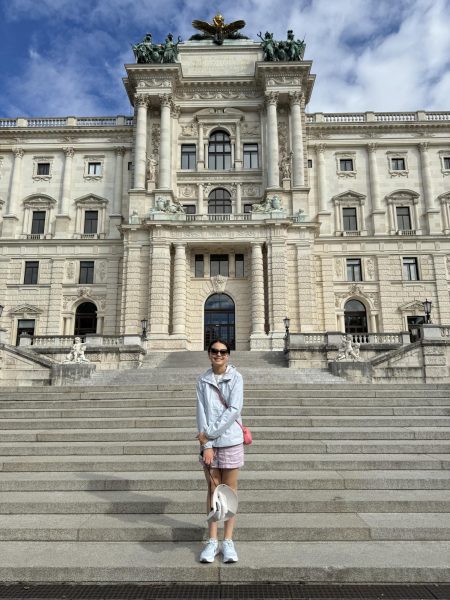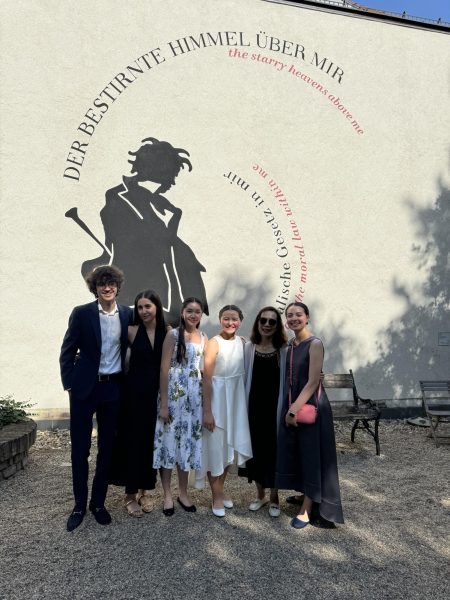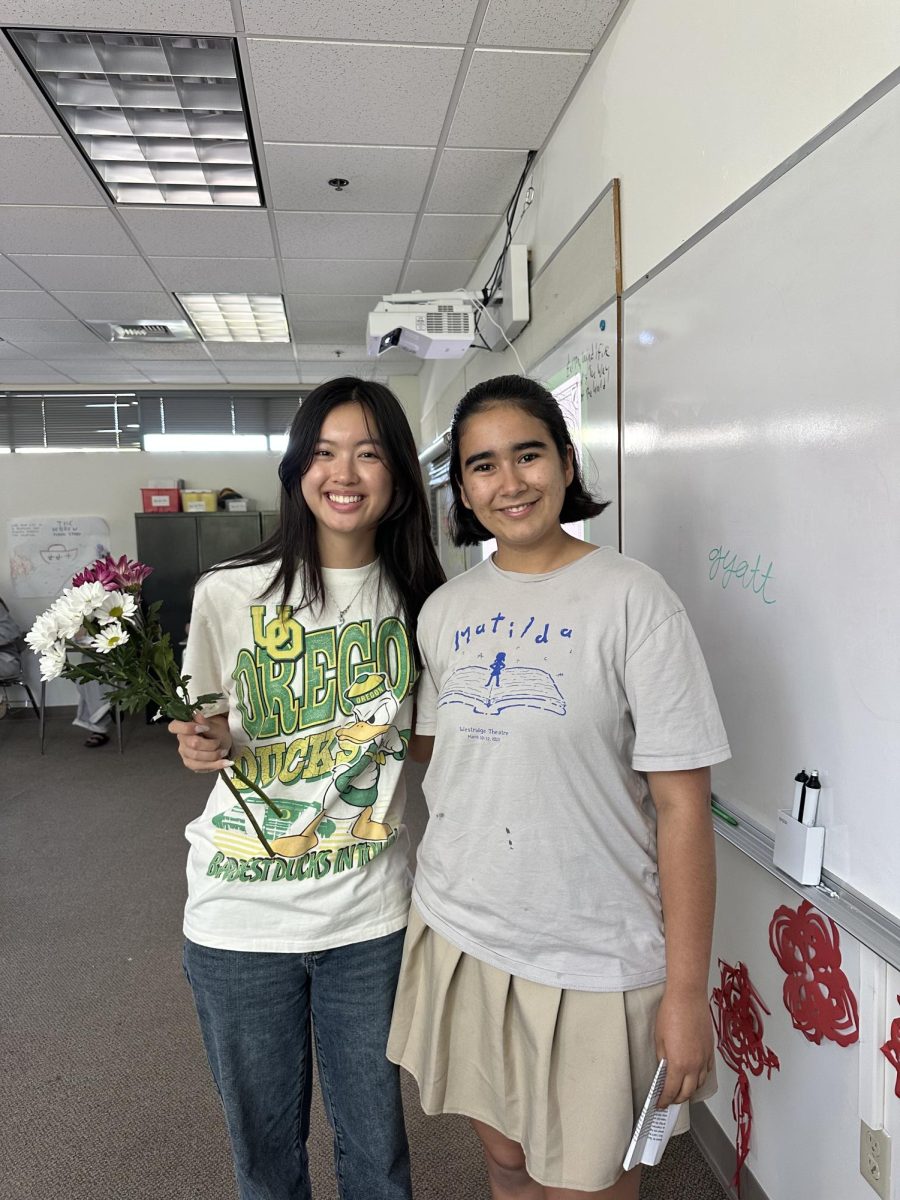Sitting in the front row of the Beethoven Museum, my nerves tingled, and butterflies fluttered in my stomach while I waited for my turn to perform. The familiar scent of polished wood and the noise of car tires bouncing along a cobblestone road outside helped divert my thoughts and calm my racing heart. The hushed murmurs of the audience brought back memories of my previous performances in Vienna, and yet, despite my familiarity with the museum, this time felt different. The weight of the moment pressed down on me—this wasn’t just another practice; it was the recital. After months memorizing notes and finger sequences—of not one but two long pieces—I was finally about to perform.

My journey in Vienna began in 2017 when I had the honor of performing at multiple recitals for the Beethoven Museum’s grand reopening along with other students from my Chicago-based piano studio, the Lincoln Park Music Center. Five years later in 2022, we returned to celebrate Beethoven’s 250th birthday celebration with more performances. Each visit deepened my connection to the city and its rich musical heritage while teaching me valuable life lessons about perseverance, passion, and growth.
This year, we once again traveled to Vienna to perform at the Beethoven Museum but also at the Wien Museum, Vienna’s newly reopened main city museum. We had one big concert at the Wien Museum and eight smaller performances at the Beethoven Museum over the course of two days. I was delighted to perform in three of these concerts, including the special one-hour joint recital for just my sister and me.
For our joint recital, I prepared two of Beethoven’s pieces: Sonata in D Minor, Op. 31, No. 2 (“Tempest” Sonata) and Rondo Alla Ingharese Quasi un Capriccio in G Major (“Rage Over a Lost Penny”). While “Rage over a Lost Penny” was lively and joyful and suited to my personality, the “Tempest” Sonata posed a much greater emotional challenge.
The “Tempest” Sonata, with its serious and intense nature, reflects a turning point in Beethoven’s life. During its composition at his residence that was later converted into the Beethoven Museum, he faced deep personal turmoil and even contemplated suicide after he was forced to confront the loss of his hearing. Ultimately, he chose to continue living and later would compose some of his most important works.
Conveying that depth of emotion initially felt beyond my reach. Unlike the joyous and light-hearted “Rage Over a Lost Penny,” the “Tempest” required me to immerse myself with darker, more intense feelings. My half-hearted attempts were met with stern reproach from my piano teacher, Miss Whedo Kim, who urged me many times to put more feeling and empathy into my performance. “You should want to be better,” she encouraged, as she pushed me to go beyond playing the right notes and dynamics.
But I didn’t feel connected with Beethoven’s struggles, and every reluctant attempt I took to convey the piece’s emotional depth felt artificial and dull. It wasn’t easy to be more emotional and empathize with Beethoven’s emotions. Afterall, what exactly do I know about loss or suffering? I didn’t even want to try to empathize with such serious and heavy emotions, especially when I was personally feeling joyful and excited.
So I just avoided it and focused my attention on the technical precision. But the issue was that I wasn’t even practicing to improve. I just wanted to ease my guilty conscience, trying to out-play the emotional demands instead of facing them head on.
And it wasn’t working. My piano teacher made that clear. Although it was hard for me to relate to Beethoven’s emotions, without doing so, I wouldn’t be playing “accurately” and “conveying the true feelings to the audience,” as my piano teacher told me many times. I realized that I needed to take this seriously and at least truly try before giving up.

With the performance soon approaching, I decided that I needed to work harder on the emotional aspect of the “Tempest” to make the piece truly the “Tempest.” Instead of trying harder with my hands, I started listening to the sonata over and over again. I tried to focus not just on the notes but connecting them with Beethoven’s emotions.
As I listened, certain details began to stand out, like the way Beethoven shifted from sharp, tense chords to unexpectedly soft and melodic passages. While these details were small, they were important and communicated Beethoven’s inner frustration and struggle to hold onto the smallest flicker of hope.
In the hours of determined practice that followed, I tried changing my musical touch and dynamics to channel his turmoil and ultimate perseverance. I experimented with my touch, making bigger crescendos and lingering over the quieter parts, trying to convey Beethoven’s despair but also the shimmer of hope that lingered. I gradually realized that I wasn’t just playing Beethoven’s notes; I was listening to his struggle, despair, and resilience. While it was uncomfortable at first, I found myself sinking into the music as I repeated these phrases and discovered a capacity for empathy and persistence in the process.
While I struggled to capture the emotional depth of the sonata, Beethoven grappled with the loss of his hearing and his connection to music. Maybe writing the “Tempest” Sonata was his way of navigating through his despair, as it gave him the moment to process and transform it into something beautiful instead.
Playing Beethoven’s “Tempest” Sonata taught me about a different kind of resilience. We often think of resilience as a kind of pushing forward, but it’s also about the willingness to be open to uncomfortable situations and emotional challenges. It took courage for me to emotionally connect, but I learned a lot more about piano and myself in the process. I’ve learned that it isn’t just important to work hard, but I also need to be willing to face the discomfort that comes with emotional vulnerability.
As I look back on these precious memories, my performance in Vienna was more than just a concert. Just as the “Tempest” marked a turning point in Beethoven’s life, this concert marked one in mine. As I embark on new challenges in high school and beyond, I now understand that resilience isn’t just about pushing forward; it’s about being willing to embrace discomfort, both in music and life.




























![Dr. Zanita Kelly, Director of Lower and Middle School, pictured above, and the rest of Westridge Administration were instrumental to providing Westridge faculty and staff the support they needed after the Eaton fire. "[Teachers] are part of the community," said Dr. Kelly. "Just like our families and students."](https://westridgespyglass.org/wp-content/uploads/2025/03/dr.-kellyyy-1-e1748143600809.png)

























Isis • Oct 7, 2024 at 11:57 am
what a beautiful article karalim!!